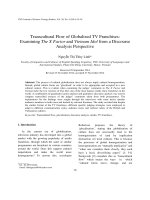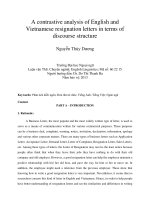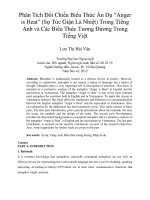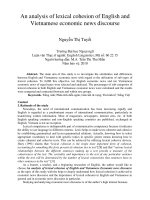The Syntactic and Lexical Features of English and Vietnamese Newspaper Headlines A Contrastive Analysis
Bạn đang xem bản rút gọn của tài liệu. Xem và tải ngay bản đầy đủ của tài liệu tại đây (476.19 KB, 8 trang )
The Syntactic and Lexical Features of English
and Vietnamese Newspaper Headlines: A
Contrastive Analysis
Phạm Hồng Phượng
Trường Đại học Ngoại ngữ
Luận văn ThS. Chuyên ngành: English Linguistics; Mã số: 60 22 15
Người hướng dẫn: Dr. Nguyễn Huy Kỷ
Năm bảo vệ: 2011
Abstract: Considering the absence of contrasting English and Vietnamese newspaper
headlines, this study was an attempt to conduct a contrastive analysis between the
newspaper headlines of English and Vietnamese languages in order to explore how they
are different. The analysis was based on a four-day corpus of the headlines. Utilizing
contrastive analysis, the researcher analyzed the variability of syntactic and lexical
features across and within the English and Vietnamese headlines. It was concluded that
they are similar in using headlines by simple sentences, noun phrases, and dynamic verbs
with active structure. Different characteristics can be found in the use of functional
headlines, non-finite clauses, verbless clauses, modification in nominal headlines, some
parts of speech, and omission of words. This study has pedagogical implications for
teaching journalistic English and translation.
Keywords: Tiếng Anh; Phương pháp giảng dạy; Từ vựng; Cú pháp
8
TABLE OF CONTENTS
CANDIDATE’S STATEMENT
i
ACKNOWLEDGEMENTS
ii
LIST OF ABBREVIATIONS
iii
LIST OF TABLES
iv
ABSTRACT
v
PART A: INTRODUCTION
1. Rationale of the study
2. Objectives of the study
3. Research questions
4. Scope of the study
5. Methods of the study
6. Design of the study
PART B: DEVELOPMENT
CHAPTER 1: LITERATURE REVIEW AND THEORETICAL BACKGROUND
1.1. Literature review
1.1.1. Language of headlines
1.1.2. Complexity in headlines
1.1.3. Typical features of headlines
1.1.4. Contrastive analyses on headlines
1.1.5. Studies on headlines in Vietnam
1.2. Theoretical background
1.2.1. Newspaper headlines
1.2.1.1. Concepts of headlines
1.2.1.2. Functions of headlines
1.2.2. Syntactic and lexical features
1.2.2.1. Syntactic features
1.2.2.2. Lexical features
CHAPTER 2: ANALYSIS ON COLLECTED NEWSPAPER HEADLINES
2.1. Materials
1
2
2
2
2
2
3
4
4
4
4
4
4
5
6
7
7
7
7
8
8
14
18
18
9
2.2. Procedure
2.3. Data analysis
2.3.1. First level of analysis
2.3.1.1. Structural headline types
2.3.1.2. Functional headline types
2.3.2. Second level of analysis
2.3.2.1. Parts of speech in sample headlines
2.3.2.2. Omissions in headlines
2.4. Summary
CHAPTER 3: FINDINGS AND IMPLICATIONS
3.1. Similar features of English and Vietnamese newspaper headlines
-
3.1.1. Syntactic similarities
3.1.2. Lexical similarities
3.2. Different features of English and Vietnamese newspaper headlines
3.2.1. Syntactic differences
3.2.2. Lexical differences
3.3. Pedagogical implications
3.3.1. Implications for teaching journalistic English
3.3.2. Implications for teaching translation
3.4. Summary
PART C: CONCLUSION
1. Recapitulation
2. Limitations of the study
3. Suggestions for further studies
REFERENCES
APPENDIX
18
19
19
19
26
27
27
30
31
32
32
32
33
33
30
36
36
36
37
37
38
38
39
39
40
I
10
PART A: INTRODUCTION
1. Rationale of the study
It is undeniable that our country has been moving towards globalization and trade
liberalization. To be successful, we have opened to welcome foreign investment for many
years and now we still need to continuously understand the political and economic
situations of other countries. In such a situation, information has played a vital role up to
now. Newspapers are one of the most popular means of transmitting information which has
attracted a great number of readers.
Conventionally, it is believed that newspapers have more readers than any other
kind of written text. According to Van Dijk (1986:156), "for most citizens, news is perhaps
the type of written discourse with which they are confronted most frequently". Reading
newspapers in English, in fact, has always been an interest of English learners. Newspapers
are everywhere but how to read in an easy way to understand is still a problem. Moreover,
as teachers of English, how to teach students to translate, to write and to understand
English press in an effective way is really a big question.
In a newspaper, it is the headline that has the highest readership. It is always the
first thing that everyone notices when picking up a newspaper. It serves as a guide for
readers that helps decide whether to continue on reading the whole report or to skip onto
another one. Each headline summarizes the content of a story, and entices an audience into
reading the article. Newspaper headlines are particularly important for the way readers
comprehend a news text, they are markers that monitor attention, perception and the
reading process (Van Dijk, 1988).
Many students of English find that newspaper headlines are especially difficult to
understand. Obviously, it is not just a matter of vocabulary; even the style of writing is
different from any other text they have met in their studies. The language of headlines is
special and has its own characteristics on the lexical, syntactic, and rhetorical levels for its
brevity, attractiveness, and clarity (Danuta R., 1998). These language features pose a great
challenge to foreign learners of English when they begin to read English newspapers.
The key to ease the difficulty of this special genre lies on the comparison between
foreign and native languages (Connor, 1996). Thereby, this study is conducted to
investigate the similar and different features in the newspaper headlines of English and
11
Vietnamese languages. From the findings, I hope partly to guide Vietnamese learners and
teachers of English towards the effective way of mastering English.
2. Objectives of the study
In the light of Contrastive Analysis, this study attempts to contrast English and
Vietnamese newspaper headlines, which concentrates on the following objectives:
Studying the syntactic and lexical features of English and Vietnamese newspaper
headlines;
Contrastively comparing the newspaper headlines of the two languages syntactically
and lexically to find the similarities and mainly differences between them;
Drawing out the practical applications in English language teaching and translation.
3. Research questions
In order to achieve the objectives, during the process of carrying the research, the
following research questions are raised for exploration:
1. What are the syntactic and lexical features of English and Vietnamese newspaper
headlines?
2. What are the similarities and differences in the syntactic and lexical features of
English and Vietnamese newspaper headlines?
3. What pedagogical implications does the study have for Vietnamese teachers of
English?
4. Scope of the study
Due to the limit in time and within the framework of an M.A. thesis, it is
impossible for a study to deal with all the features of language theory and practice in depth.
This study, therefore, only focuses on some syntactic and lexical features found in the
newspapers headlines of English and Vietnamese to see how they are different.
5. Methods of the study
In the thesis, the main methods used are description and contrastive comparison of
the two languages in newspaper headlines including:
Describing the syntactic and lexical features in the English and Vietnamese headlines
collected from The New York Times and Hà Nội Mới newspapers.
Contrastively comparing those features in English and Vietnamese newspaper
headlines with concrete contrasting techniques, namely, analysis and statistics.
12
6. Design of the study
This thesis consists of three parts:
Part A is the introduction which shows the reasons why the topic is chosen, what
the study aims at as well as the scope of the study and some outlook on methodology.
Part B consists of 3 chapters. Chapter 1 discusses the review of related literature
and theoretical background of every matter mentioned in the title of the study. Chapter 2
and 3 are the analysis of the headlines selected, the major findings and discussions with
some implications for learning and teaching English.
Part C is the conclusion which presents the recapitulation of the study, the
limitations of the study and some suggestions for further researches.
49
REFERENCES
In English:
1. Ánh, Bùi Nguyệt. 2003. Some Discourse Features of Newspaper Headlines and
Articles in English. M.A. Thesis. Vietnam National University, Hanoi. University
of Foreign Languages and International Studies.
2. Mc Arthur, T.1992. The Oxford Companion To The English Language. Oxford:
Oxford University Press
3. Baddock, B. 1988. SCOOP: Communicative Activities with British and American
Newspapers. New York: Prentice Hall.
4. Bell, A. 1991. The Language of News Media. Oxford: Blackwell publishers.
5. Biber, Douglas, et. al. 1999. Longman Grammar of Spoken and Written English.
Harlow: Pearson.
6. Bích, Nguyễn. 2009. English – Vietnamese translation of electronic news
headlines. M.A. Thesis. Vietnam National University, Hanoi. University of Foreign
Languages and International Studies.
7. Brisau, A. 1969. Complex sentence structure in headlines: Cambridge University
Press.
8. Connor, U. 1996. Contrastive Rhetoric: Cross Cultural Aspects of Second
Language Writing: Cambridge University Press.
9. Crystal, D. 1992. An Encyclopedic Dictionary of Language and Languages.
Oxford: Blackwell Publishers.
10. Crystal, D. 2006. Language and the Internet: Cambridge University Press.
11. Danuta, R. 1998. The Language of Newspapers. London and New York: Routledge.
12. Develotte, C., & Rechniewski, E. 2000. Discourse analysis of newspaper
headlines: A methodological framework for research into national representations.
10 Jan 2002. < titles.htm.>
13. Fallahi, M. 1991. Contrastive Linguistics and Analysis of Errors. Vol. 1. Tehran:
Iran University Press.
14. Gimmer, R. 1997. Webster’s New Collegiate Dictionary. G&C Marriam Co.
15. Leech, G., & Svartvik, J. 1994. A Communicative Grammar of English. London:
Longman.
16. Leech, G.N. 2006. A Glossary of English Grammar. Edinburgh University Press.
17. Lefevere, A. 1992. Translation, History, Culture. New York: Routledge.
18. Mardh, I. 1980. Headlines on the Grammar of English Front Page Headlines.
Lund: Gleerup.
19. McLoughlin, L. 2000. The Language of Magazines. London: Routledge.
20. Murphy, R. 1997. Grammar in Use. New York: Cambridge University Press.
21. Quirk, R., Greenbaum, S., Leech, G., & Svatvik, J. 1985. A Comprehensive
Grammar of the English Language. London: Longman Publisher.
22. Radford, A. 1997. Syntax: A Minimalist Introduction. N. K.: Cambridge University
Press.
23. Sanderson, P. 1999. Using Newspapers in the Classroom. New York: Cambridge
University Press.
50
24. Scollon, R. 2000. Generic variability in news stories in Chinese and English: A
contrastive discourse study of five days' newspapers. Journal of Pragmatics, 32,
761-791.
25. Sinclair, J. 1998. English Language Dictionary. London
26. Straumann, H. 1935. Newspaper Headlines. A Study in Linguistic Method. London.
27. Maggie, T. 1998. Understanding Syntax. Oxford University Press.
28. Trang, Phan Vũ Thùy. 2008. A study on translating English newspaper headlines
into Vietnamese newspaper headlines on Dantri online newspaper. M.A. Thesis.
Vietnam National University, Hanoi. University of Foreign Languages and
International Studies.
29. Turner, G. W. 1972. The grammar of newspaper headlines containing the
preposition on in the sense 'about'. Linguistics, 87, 71-86.
30. Ungerer, F. (Ed.) 2000. English Media Texts - Past and Present Language and
Textual Structure. Philadelphia PA: John Benjamins.
31. Van Dijk, T. A. 1986. News Schemata. New York: Dans Cooper and Greenbaum.
32. Van Dijk, T. A. 1988. News as Discourse. Hillsdale, NJ.: Lawrence Erlbaum.
33. Website:
In Vietnamese:
1. Diệp Quang Ban & Hoàng Văn Thung. 2009. Ngữ Pháp Tiếng Việt, Tập 1. Nhà xuất
bản Giáo dục
2. Diệp Quang Ban. 2009. Ngữ Pháp Tiếng Việt, Tập 2. Nhà xuất bản giáo dục
3. Nguyễn Tài Cẩn. 1999. Ngữ Pháp Tiếng Việt: Tiếng – Từ Ghép – Đoản Ngữ. Nhà
xuất bản Đại học Quốc gia Hà Nội
4. Đỗ Hữu Châu. 2007. Giáo Trình Từ Vựng Học Tiếng Việt. Nhà xuất bản Đại học sư
phạm.
5. Đỗ Hữu Châu. 1999. Từ Vựng – Ngữ Nghĩa Tiếng Việt. Nhà xuất bản Giáo dục.
6. Nguyễn Thiện Giáp. 1999. Từ Vựng Tiếng Việtt. Nhà xuất bản Giáo dục.
7. Cao Xuân Hạo. 1991. Ngữ Pháp Chức Năng. Nhà xuất bản Khoa học xã hội.
8. Nguyễn Chí Hòa. 2009. Ngữ Pháp Tiếng Việt Thực Hành. Nhà xuất bản Đại học
Quốc gia Hà Nội.
9. Trần Hữu Mạnh. 2007. Ngôn Ngữ Học Đối Chiếu Cú Pháp Tiếng Anh – Tiếng Việt.
Nhà xuất bản Đại học Quốc gia Hà Nội.
10. Trần Hữu Mạnh. 2005. Danh Ngữ và Vấn Đề Danh Hóa Trong Tiếng Anh và Tiếng
Việt. Nhà xuất bản Khoa học xã hội.
11. Hoàng Trọng Phiến. 1996. Ngữ Pháp Tiếng Việt. Nhà xuất bản Đại học Quốc gia
Hà Nội.
12. Website:









